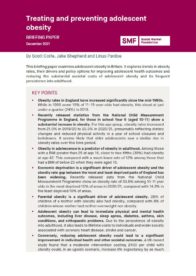This briefing paper examines adolescent obesity in Britain. It explores trends in obesity rates, their drivers and policy options for improving adolescent health outcomes and reducing the substantial societal costs of adolescent obesity and its frequent persistence into adulthood.
KEY POINTS
- Obesity rates in England have increased significantly since the mid-1990s. While in 1995 some 15% of 11–15-year-olds had obesity, this stood at just under a quarter (24%) in 2019.
- Recently released statistics from the National Child Measurement Programme in England, for those in school Year 6 (aged 10-11) show a substantial increase in obesity. For this age group, obesity rates increased from 21.0% in 2019/20 to 25.5% in 2020/21, presumably reflecting dietary changes and reduced physical activity in a year of school closures and lockdowns. It seems likely that older adolescents saw a similar rise in obesity rates over this time period.
- Obesity in adolescence is a predictor of obesity in adulthood. Among those with a BMI greater than 25 at age 16, close to two-fifths (39%) had obesity at age 42. This compared with a much lower rate of 12% among those that had a BMI of below 25 when they were aged 16.
- Economic deprivation is a significant driver of adolescent obesity and the obesity rate gap between the most and least deprived parts of England has been widening. Recently released data from the National Child Measurement Programme show an obesity rate of 33.8% among 10-11 year olds in the most deprived 10% of areas in 2020/21, compared with 14.3% in the least deprived 10% of areas.
- Parental obesity is a significant driver of adolescent obesity. 28% of children of a mother with obesity also had obesity, compared with 8% of children whose mother had neither overweight nor obesity.
- Adolescent obesity can lead to immediate physical and mental health outcomes, including liver disease, sleep apnea, diabetes, asthma, skin conditions, and orthopaedic problems. Due to the persistence of obesity into adulthood, it also leads to lifetime costs to individuals and wider society associated with coronary heart disease, stroke and cancer.
- Conversely, reducing adolescent obesity could lead to a significant improvement in individual health and other societal outcomes. A UK-based study found that a moderate intervention costing £400 per child with obesity could, in an upside scenario, increase life expectancy by as much as one year. It could also save the NHS thousands of pounds, per child, from reduced lifetime costs of diabetes, coronary heart disease, stroke and cancer.
RECOMMENDATIONS
Adolescent obesity is a complex public health issue, with many contributing factors. There is no silver bullet intervention that will, in isolation, reduce obesity rates through treatment or prevention. Ultimately, a “whole systems” approach to reducing adolescent obesity is likely to be necessary – taking into account the wide range of drivers, from healthy food affordability to the built environment to weight management services.
Within this whole systems approach, policy needs to:
- Create new long-term, local-level partnerships and expand upon existing ones, drawing on examples of best practice from the UK and overseas. Metro mayors, local authorities and integrated care systems should deliver interventions targeted at the specific challenges of a given locality – such as economic deprivation and an urban landscape that discourages physical activity.
- Central government should commit to a sustained and sizeable cash injection to support the formation of new partnerships and the expansion of existing ones.
- Expand access to family-level interventions which encourage whole households to take steps to lead healthier lives. At present, efforts to manage a child or young person’s weight are not always supported, and are sometimes undermined, by members of the wider family. Further, many young people with overweight and obesity may have, or come from a family with, a history of failed attempts to manage their weight. New interventions that address the family dynamics are necessary.
- School-based interventions should be explored by policymakers and schools. Such initiatives could include family “homework” assignments to promote healthier living, making school playing fields and playgrounds accessible after school hours and promoting non-competitive activities during physical education classes.
- Academy schools should be required to meet these national food standards. At present, the exclusion of academy schools from national school food standards reduces the ability of government to introduce school-based interventions-related to diet.
- The National Child Measurement Programme should also be overhauled, with feedback letters for parents on their child’s weight being mandatory (rather than merely encouraged) and complemented with more constructive material supporting families to take steps to access support and lead healthier lives.


